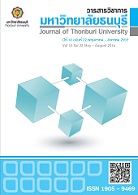แนวทางการเผยแผ่พระพุทธศาสนาของพระภิกษุและสามเณรชนเผ่าในเขตการปกครองคณะสงฆ์ภาค 7
Keywords:
ปัญหาอุปสรรคในการเผยแผ่พระพุทธศาสนา, การเผยแผ่พระพุทธศาสนา, พระภิกษุสามเณรชนเผ่า, problems and obstacles in propagation of Buddhism, the propagation of Buddhism, the hill tribe monks and novices,Abstract
การวิจัยครั้งนี้ พบว่าปัญหาและอุปสรรคในการเผยแผ่พระพุทธศาสนาของพระภิกษุและสามเณรชนเผ่า ในเขตการปกครองคณะสงฆ์ภาค 7 อยู่ในระดับที่มีปัญหาน้อย แต่ก็มีแนวโน้มที่จะมีปัญหา เพราะเมื่อพิจารณาจำแนกตามองค์ประกอบของปัญหาพบว่า การที่พระภิกษุและสามเณรชนเผ่ามีองค์ความรู้ไม่เพียงพอในการเผยแผ่พระพุทธศาสนา และความไม่ต่อเนื่องในการประพฤติและปฏิบัติตามแนววิถีพุทธอยู่ในระดับที่มีปัญหา ( = 2.96 และ 2.74)
ปัจจัยที่มีความสัมพันธ์ต่อปัญหาและอุปสรรคในการเผยแผ่พระพุทธศาสนาของพระภิกษุและสามเณรชนเผ่า ในเขตการปกครองคณะสงฆ์ภาค 7 ได้แก่ การขาดการนิเทศและการตรวจการของคณะสงฆ์ และความห่างไกลจากศูนย์กลางความเจริญ
แนวทางที่เหมาะสมในการเผยแผ่พระพุทธศาสนาของพระภิกษุและสามเณรชนเผ่า ในเขตการปกครองคณะสงฆ์ภาค 7 ต้องให้ความสำคัญในเรื่องต่อไปนี้
1. คณะสงฆ์ต้องให้ความสำคัญเรื่องการบริหารจัดการ ควรมีการจัดระบบการนิเทศงาน เน้นการให้คำปรึกษาแนะนำทั้งในด้านความชัดเจนของเนื้อหา การพัฒนาศักยภาพ เทคนิคการเผยแผ่ สนับสนุนความสามารถพิเศษส่วนบุคคล เพื่อเพิ่มศรัทธาแก่พุทธศาสนิกชนที่เป็นชนเผ่า ใช้เทคโนโลยีการสื่อสารการคมนาคมสมัยใหม่
2. การปฏิบัติงานของพระภิกษุและสามเณร ควรมีการปฏิบัติงานในลักษณะทีมงานหรือเครือข่ายการทำงาน โดยใช้พื้นที่เป็นฐานในการแบ่งกลุ่มเพื่อที่จะสามารถช่วยเหลือกันได้อย่างเหมาะสม
3. ควรเปิดโอกาสให้ชาวบ้านในชุมชนเป็นผู้มีบทบาทในการดูแลและบำรุงรักษาพุทธศาสนสถานร่วมกับพระภิกษุและสามเณร
4. การจัดกิจกรรมทางพระพุทธศาสนาเนื่องในวันสำคัญ ควรมีการแลกเปลี่ยนกับวัดหรือพุทธศาสนสถานขนาดใหญ่ในชุมชนเมือง เพื่อสร้างสัมพันธภาพร่วมกัน ซึ่งจะก่อให้เกิดเครือข่ายในการทำงานร่วมกันต่อไปในอนาคต
THE SUCCESS OF PROPAGATION’S THE HILL TRIBE BUDDHIST MONKS IN SANGKHA REGION 7
The research findings showed that problems and obstacles in the hill-tribe Buddhist Clergymen’s propagation of Buddhism in an area of the jurisdiction of the Ecclesiastical Organization Region 7 were rated at a low level. But such propagation seemed to have a trend to face the problem. That is why, when considering by factor of the problem, it was found that the lacking of knowledge for the propagation of Buddhism on part of the tribal Buddhist Clergymen and irregularity of the performance and observance of the Buddhist ways were found at a problematic level ( = 2.96 and 2.74).
The factors affecting the problems and obstacles in the hill-tribe Buddhist clergymen’s propagation of Buddhism in an area of the jurisdiction of the Ecclesiastical Organization Region 7 included the lacking of the Sangha directing and inspecting as well as its isolation from the center of development.
As for appropriate strategy in the hill-tribe Buddhist clergymen’s propagation of Buddhism in an area of the jurisdiction of the Ecclesiastical Organization Region 7, the involving authority had to prioritize the following issues.
1. The Buddhist Sangha had to realize the significance of administration, in which there should be directing system with emphasis on counseling in terms of clarity of the subject matter, skill development, propagation technique, and personal ability support in order to step up the tribal Buddhists’ faith through utilization of some modern communication technologies.
2. With regard to the Buddhist clergymen’s operation, there should be teamwork-based performance by using the target area as basis for dividing it into groupings so as to make possible the mutual aids.
3. The villagers in community should be given opportunity to play role in taking care of, and maintaining, the Buddhist architectures in collaboration of the monks and novices.
4. With regard to Buddhist events organizing on important festive occasions, there should be some exchange between the big monastery and Buddhist institution in an urban area in order to create relationship. That would consequently results in emergence of cooperation network in the future.







